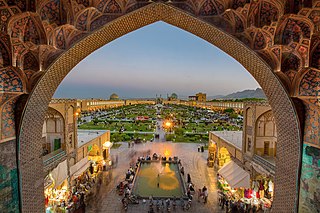
Isfahan is a major city in the Central District of the Isfahan Province of Iran. It is located 440 kilometres south of Tehran and is the capital of Isfahan Province. The city has a population of approximately 2,220,000, making it the third-largest city in Iran, after Tehran and Mashhad, and the second-largest metropolitan area.

Isfahan Province, also transliterated as Esfahan, Espahan, Isfahan, or Isphahan, is one of the 31 provinces of Iran. The capital of the province is the city of Isfahan. It is located in the center of the country in Iran's Region 2, whose secretariat is located in Isfahan.

The river Narva, formerly also Narwa or Narova, flows 77 kilometres (48 mi) north into the Baltic Sea and is the largest Estonian river by discharge. A similar length of land far to the south, together with it and a much longer intermediate lake, Lake Peipus, all together nowadays form the international border between Estonia and Russia.

Zayanderud or Zayandehrud, also spelled as Zayanderud or Zayanderood, ..., is the largest river of the Iranian Plateau in central Iran.
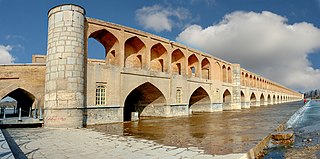
The Allahverdi Khan Bridge, popularly known as Si-o-se-pol, is the largest of the eleven historical bridges on the Zayanderud, the largest river of the Iranian Plateau, in Isfahan, Iran.
Zarrin Shahr is a city in the Central District of Lenjan County, Isfahan province, Iran, and serves as both capital of the county and of the district. It is in the southwest of the county.

Falavarjan County is in Isfahan province, Iran. Its capital is the city of Falavarjan.

The Khaju Bridge is one of the historical bridges on the Zayanderud, the largest river of the Iranian Plateau, in Isfahan, Iran. Serving as both a bridge and a weir, it links the Khaju quarter on the north bank with the Zoroastrian quarter across the Zayanderud. It is located at the end of Kamal Ismail Street in Isfahan.

Chadegan is a city in the Central District of Chadegan County, Isfahan province, Iran, and serves as both capital of the county and of the district.
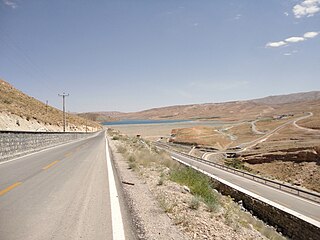
Koohrang is the name of a river, originating in the Zagros mountains of western Iran, which joins the Beheštābād river to form the Karun, Iran's largest river. A series of tunnels have been built since the 1950s to redirect some of the Kuhrang's water toward the Zayandeh River to meet the demands of increased population in Esfahan and Yazd provinces.

Gavkhouni also written as Gawkhuni or Batlaq-e-Gavkhuni, located in the Iranian Plateau in central Iran, east of city of Isfahan, is the terminal basin of the Zayandeh River. Gavkhouni is a salt marsh with a salinity of 31.5% and an average depth of about 1 m. The salt marsh can dry up in summer. The Zayandeh River originates in the Zagros mountains and travels around 300 km, before terminating in Gavkhouni.

Felezi Bridge is a bridge in Isfahan, Iran, the first modern bridge built in the city, during the 1950s, over the Zayandeh River.
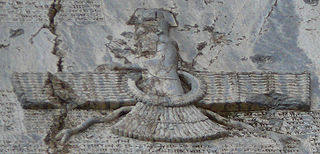
Zayandeh River Culture is a hypothetical pre-historic culture that is theorized to have flourished around the Zayandeh River in Iran in the 6th millennium BC.
The Kouhrang 2 Hydroelectric Power Station is located just south of Chelgard and about 69 km (43 mi) northwest of Shahrekord in Chaharmahal and Bakhtiari Province, Iran. The power station has an installed capacity of 33.3 MW and uses water diverted to the east from the Kouhrang River, via a small dam and the 2 km (1.2 mi) long Kouhrang 2 Tunnel, to produce power. Water from the Kouhrang is stored in a circular dam before being sent to the power station. The power station's three generators were commissioned between 2002 and 2004, the power plant were inaugurated in February 2005. Water discharged from the power station enters the Zayandeh River as part of a larger project to provide water to major cities like Isfahan. The intake for the power plant is located on the Kouhrang River just downstream of the Kouhrang 1 Dam which also diverts water, via the 2,800 m (9,200 ft) long Kouhrang 2 Tunnel, to near Chelgard and was completed in 1953. The Kouhrang 3 Dam is planned downstream to regulate river flows and divert more water to the Zayandeh via the Kouhrang 3 Tunnel.
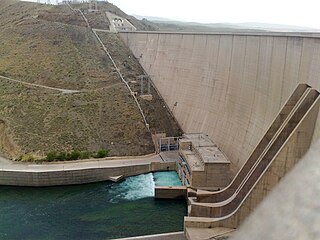
Zayanderud Dam, also spelled Zayandeh Rud Dam formerly known as the Shah Abbas Dam, is an arch dam on the Zayandeh River about 10 km (6.2 mi) east of Chadegan, Iran. The Zayanderud Dam is the main water reservoir with 1450 MCM capacity and has been exploited since 1971. The Zayanderud has provided the needs of water for important economic activities including agricultural, industrial and domestic consumptions. The primary purpose of the dam is water supply to Isfahan which lies 88 km (55 mi) to the east. It also supports a power station with an installed capacity of 55 MW. In recent years, the Zayandeh River has experienced significant reductions in flow due to a combination of drought, climate change, and overuse of water resources.
Shahrak-e Zayandeh Rud is a village in Jey Rural District, in the Central District of Isfahan County, Isfahan Province, Iran. At the 2006 census, its population was 957, in 261 families.
Zayandeh Rud is a city in Isfahan Province, Iran.
The Kouhrang 3 Dam is an arch dam currently under construction on the Kouhrang River in Chaharmahal and Bakhtiari Province, Iran. It is located about 12 km (7.5 mi) northwest of Dashtak. The purpose of the dam is water supply and river regulation. Upstream of the dam will be the intake for the 23 km (14 mi) Kouhrang 3 Tunnel which will transfer water northeast to the Zayandeh River for use in major cities like Isfahan. Sabir Co. was awarded the contract for the dam's construction in February 2011 and construction began that same year. The diversion tunnels for the dam were completed in March 2013. The project was scheduled for completed in 2015.
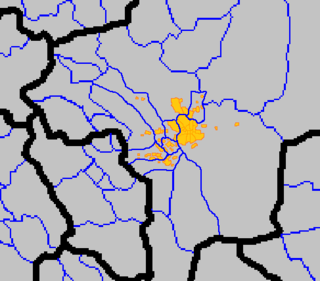
Greater Isfahan Metropolitan Area is a metropolitan region in Isfahan Province, central Iran. This region, although not having any official designation and recognition yet, is the second biggest one in Iran, behind the capital city Tehran. The overall region has a population of over 3,500,000 and extends along Zayandeh Rud, the main river axis through the province, and also along the northern-southern axis of the city, plus a western axis towards Lorestan Province. The region is a transportation hub and an industrial centre having concentrated all steel related industries in it. The region is also home to important military installations and centres, including nuclear facilities and airbases.
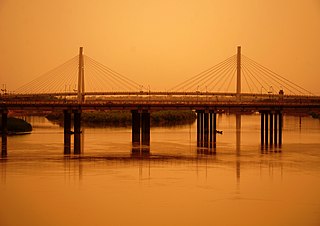
Ghadir Bridge is a bridge over the Zayanderud in Districts 4 and 6 of Isfahan. The bridge was completed in 2000.





















